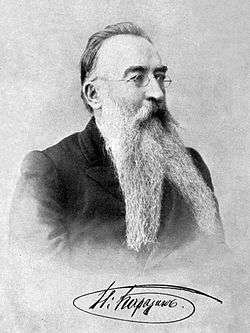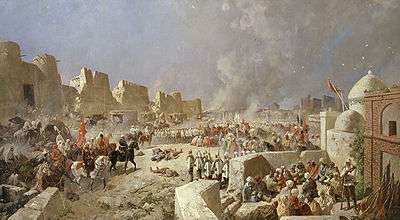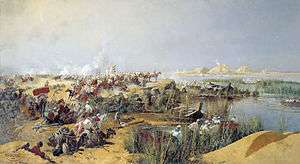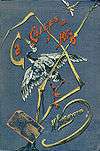Nikolay Karazin

Nikolay Nikolaevich Karazin (Russian: Николай Николаевич Каразин; born 1842, Kharkov, Russian Empire (today Ukraine) — died 1908, Gatchina, Russian Empire)[1] was a Russian military officer, painter and writer. He is mostly known for his paintings depicting wars and exotic places.
Biography
Nikolay Karazin was born to a family of enlightenment scientists. His grand father Vasily Karazin was a Greek-Bulgarian-born Russian enlightenment intellectual, inventor, and the founder of Kharkov University. His father Nikolay Vasilivech Karazin was an inventor trying to market a liquid smoke for the "instant smoking" of meats.[2]
Nikolay Karazin graduated from the Moscow cadet school in 1862. In 1865-1867 he studied at the Imperial Academy of Arts in Saint Petersburg.
As a military officer he participated in the campaign against the January Uprising in Poland (1864), and the military campaigns in Turkestan (1864–1870). In 1871 he retired from the military service[1] but as a military correspondent and illustrator he took part in the Russo-Turkish War, 1877–1878 with Serbian and Russian armies. For his military service he was awarded the Order of St. Vladimir and a gold sword. In 1874-1879 he worked with a scientific expedition exploring the Central Asia.[2] In 1885-1886 Karazin travels to India together with Ivan Minaev.[3] He also travelled to Egypt, Italy, Switzerland and many other exotic places.[4]

After his retirement from military service, Karazin wrote many adventure and ethnographic stories and novels:
- "На далеких окрайнахъ" (1875; "In the Distant Confines," tr. Anthony W. Sariti, AuthorHouse, 2007)
- "В пороховом дыму" (In the gunpowder smoke, 1878)
- "В камышах" (In the reeds, 1879)
- "Varvara Lepko and her family" (1879);
- "Тигрица" (Tigress);
- "From Orenburg to Tashkent" (1886);
- "Khiva Expedition" (1882); etc.
- The Two-Legged Wolf, English translation, 1894, from Archive.org
The most popular was his children's book, Cranes Flying South, telling the story of a crane migrating from the Ostashkov swamps to the Upper Nile. The book combined an interesting story, geographic descriptions of the places the crane flew and illustrations by the author.[5]
Later Karazin became known mostly as a painter and illustrator. He painted many large canvases devoted to battles and especially military actions in Turkestan. He was a prolific book illustrator and one of the most notable authors of the postcards. In 1902 he participated in the first (rejected by the government) project of the Moscow Metro and produced many paintings showing his vision of the project.[6] In 1904 Karazin became an academician of the Imperial Academy of Arts.
He died in 1908 in Gatchina.
Works
 Collecting brushwood in winter, 1888
Collecting brushwood in winter, 1888 Russian troops taking Samarkand
Russian troops taking Samarkand Khiva expedition of 1873. Russian troops crossing the death sands to the wells of Adam-Krylgan, 1888
Khiva expedition of 1873. Russian troops crossing the death sands to the wells of Adam-Krylgan, 1888 Russian troops crossing Amu Darya in 1873, 1889,
Russian troops crossing Amu Darya in 1873, 1889, Cover of Karazin's book From North to South: memoirs of an old crane, 1899
Cover of Karazin's book From North to South: memoirs of an old crane, 1899 Project of Moscow Metro, 1902
Project of Moscow Metro, 1902 Project of Moscow Metro, 1902
Project of Moscow Metro, 1902 Project of Moscow Metro, 1902
Project of Moscow Metro, 1902 Moscow, postcard
Moscow, postcard Postcard
Postcard
References
| Wikimedia Commons has media related to Nikolay Karazin. |
- 1 2 Biography on rulex.ru (Russian)
- 1 2 Homepage of the modern Liquid Smoke company (Russian)
- ↑ Biography of Ivan Minaev
- ↑ E.A. Vorotyntseva From the history of the Culture (Russian)
- ↑ Biography (Russian)
- ↑ History of Moscow Metro (Russian)
External links
- N. Karazin Wolf ambush (Russian)